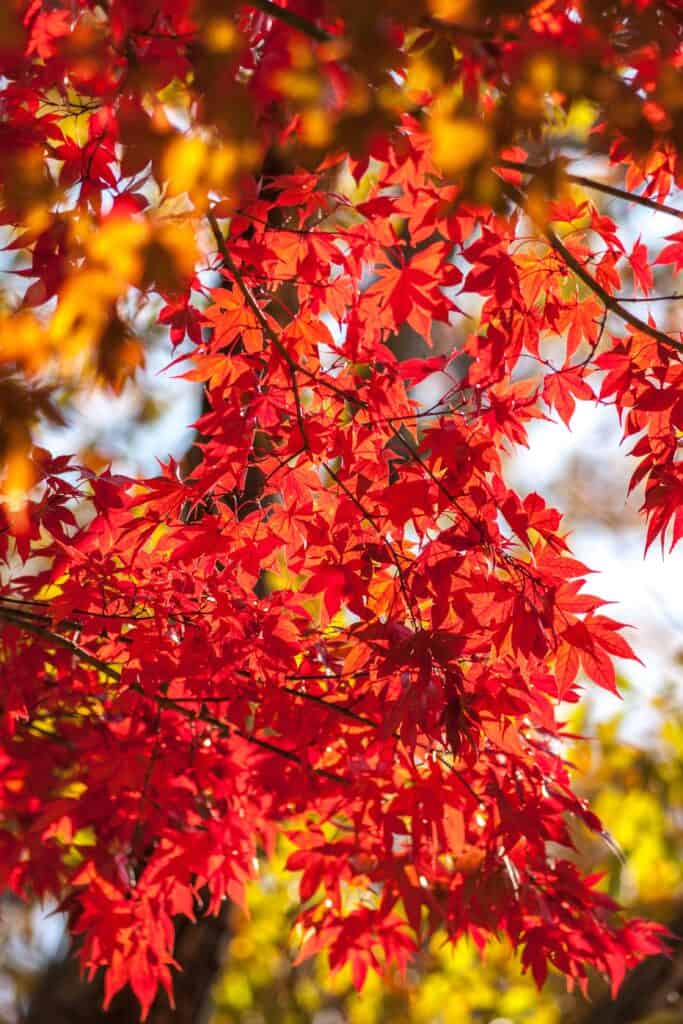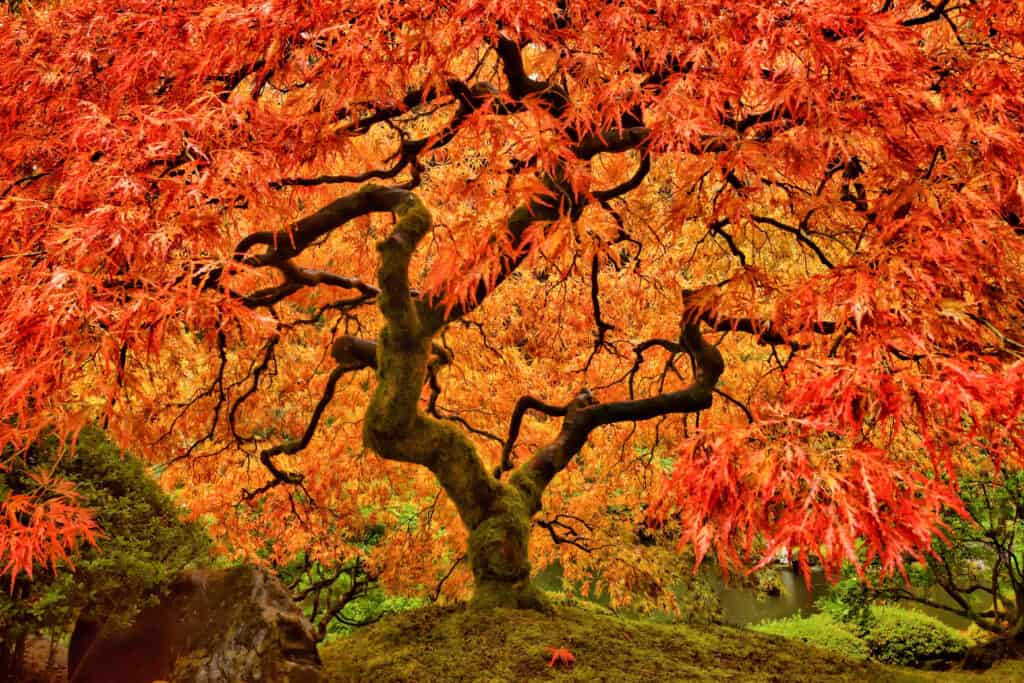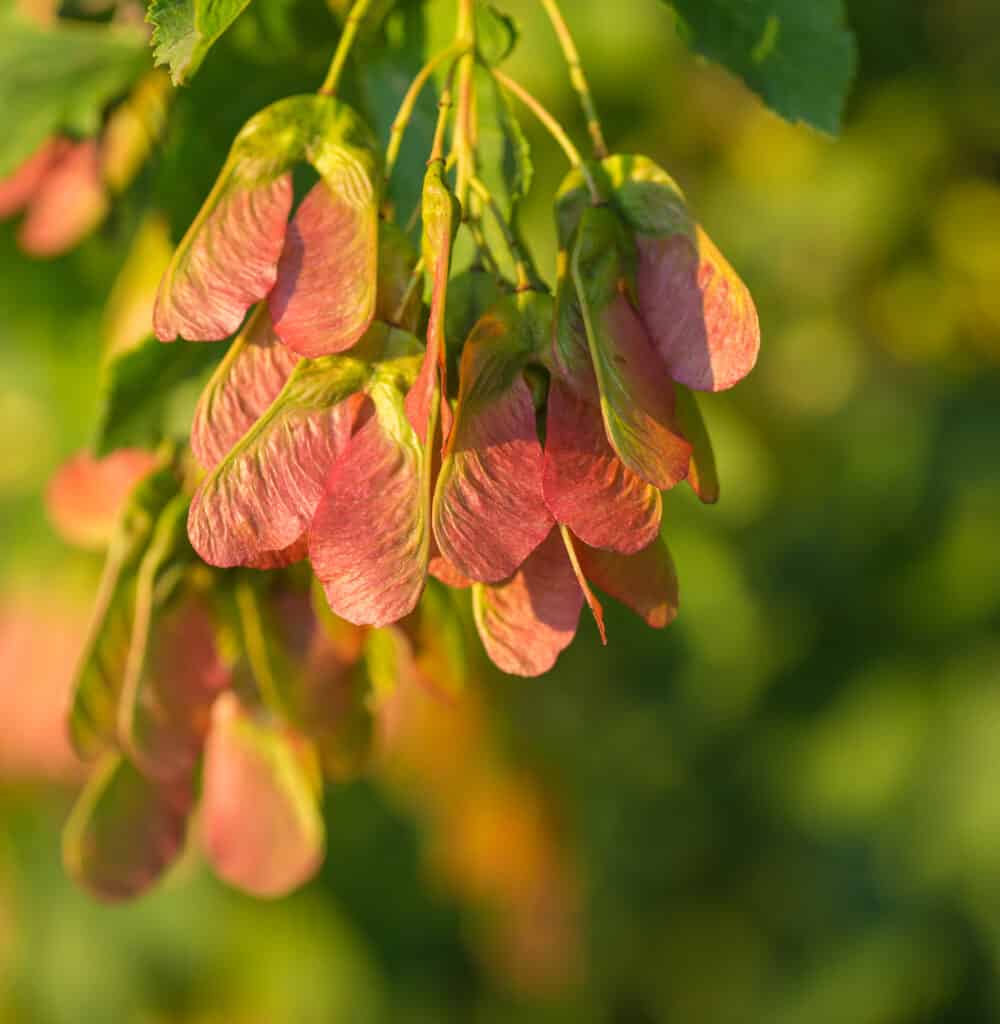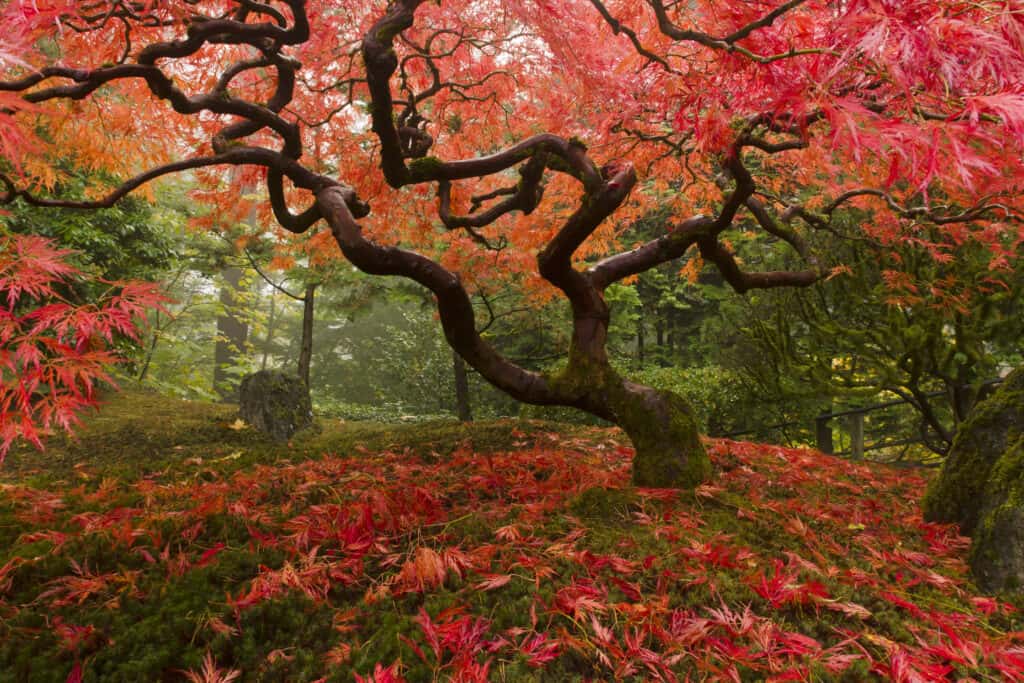Did you know that there are 132 species of maple trees in the world? Ranging from ancient Asian varieties like the Korean maple and Japanese maple to the generalized maple of North America that Canada has chosen as its national symbol, these stunning trees the world over are some of the most fascinating species you’ll find.
And of course, who doesn’t love a tree with red- and wine-colored leaves, dark oranges, bronze, golden, yellow, and even burnt ochre? Well, these two trees may look similar and have similar names, but they’re not the same species of maple and don’t actually look as similar as you might think based on the names. Let’s check out the details and see what makes them both amazing and amazingly unique.

Maple trees produce intensely beautiful shades in autumn.
©Pvince73/Shutterstock.com
| Korean Maple | Japanese Maple | |
|---|---|---|
| Classification | Acer pseudosieboldianum; There are at least 129 species of Korean maple trees. | Acer palmatum; There are over 1000 varieties and species of Japanese maple trees. |
| Description | Korean maples are small trees or shrubs with medium to dark green leaves and purple flowers and “helicopter seeds” in spring. The leaves turn colors in autumn to shades of yellow, orange, and red. | Japanese maple trees produce dark green leaves in springtime, with red-tipped winged samara and tiny red or purple flowers. They grow up to 25 feet typically and turn various shades of deep autumn and earthen tones in fall. |
| Uses | Korean maples are used as ornamental shrubs and trees in various capacities, particularly in areas where the more sensitive Japanese maples cannot grow as happily. | Japanese maples are incredibly popular with bonsai enthusiasts and are typically grown as ornamental specimens and group plants around homes, gardens, and Japanese gardens. They have been used in Chinese medicine, as well. |
| Origins and growing preferences | These popular maples are native to Korea, China, and Russia. They do best in fun sun to dappled shade, in well-drained, organic soil that is kept moist. | These colorful trees come from Japan, China, and Korea, though they were first cultivated in Japan, earning its name. They love full sun and afternoon shade in hotter climates but do not do well in arid climates. They need moist, organically rich soil, and love sandy, loamy soils. |
| Special features and fun facts | Korean maples don’t have known insect or disease issues, but they’re less well-known than Japanese maples. They’re often confused with their cousins because of the subtle differences. | Japanese maples can get sunburnt and some folks actually like to batter and fry the leaves and eat them up on salads. |
Key Differences Between Korean Maple and Japanese Maple
There are many differences between these two ornamental trees, but one of the main ones you’ll find is the tree’s preferred locales for growing.
Korean Maple vs. Japanese Maple: Classification

Japanese maples are known specifically for their incredibly vibrant autumn foliage.
©Paula Cobleigh/Shutterstock.com
Acer pseudosieboldianum, or the Korean maple, is also known as the purebloom maple. The tree belongs to the Sapindaceae family, in the acer genus. The tree is deciduous and is typically a small tree or large shrub. The tree may be seen as a “false Siebold’s maple,” which is why it is known as a “pseudo” sieboldianum. There are at least 129 species of Korean maple trees.
The Japanese maple, or Acer palmatum, is part of the same family and is known also as the palmate maple, or smooth Japanese maple. The plant is a woody plant native to Asia with many cultivars selectively grown worldwide. It is also a deciduous shrub or small tree. There are over 1000 varieties and species of Japanese maple trees.
Korean Maple vs. Japanese Maple: Description
A deciduous small tree or large shrub, Korean maples are beautiful additions for any space. The trees are compact and look delicate, thanks to its shorter status. They grow in medium to dark green leaves that are about 5 inches long, with doubly serrated lobes. The trees typically peak at 20 feet in height. The leaves change color in fall, turning orange, yellow, and red, and then purple flowers pop out in springtime. After the flowers, winged samaras (the “helicopter seeds”) come out to play in the wind as they drop and twirl through the sky. Korean maple trees do better in colder climates than Japanese maples, so they are often chosen for their hardiness and planted in the more extreme regions.
Japanese maples are another type of maple tree popular around the world for an ornamental plant. They bring out dark green leaves in springtime, followed by red-tipped winged samara. They have tiny red flowers that may occasionally look purple. The trees grow up to 25 feet in normal circumstances, with the occasional 40-foot tree showing up. The tree is usually more of a bush with a broad, rounded shape and low branching. Each leaf has 5 or 7 toothed lobes and turn yellow, red-purple, burnt orange and bronze in the autumn.

Korean maples often have both green and red leaves at the same time in autumn.
©og.moon/Shutterstock.com
Korean Maple vs. Japanese Maple: Uses
Korean maples are ornamental trees often selected for growing in colder climates that the popular Japanese maple can tolerate. They add vivid green colors in springtime and intense oranges, yellows, and reds in autumn. The plants are on the shorter side, usually not reaching higher than 20 feet, and so are often used as shorter barrier “walls” and fences. They are placed around homes, in gardens, as singular ornamental pieces at apartment complexes, and are used to help create colorful canopies in areas where lower shade trees are desired.
Japanese maples are similar to Korean maples in their use, except that they are less capable of handling colder weather. They are typically grown as specimen and accent grounds around homes, gardens, and yards, often found in Japanese gardens in public spaces, used to create borders or “fences” for properties, and may even be used as bonsai trees, when the proper species is chosen and planted accordingly. Japanese maples have been subjects of artwork for centuries and their branches and leaves have been used in Chinese medicine.

Even maple seeds are colorful.
©Ryzhkov Oleksandr/Shutterstock.com
Korean Maple vs. Japanese Maple: Origins and Growing Preferences
Korean maple, as you might guess by the name, is native to Korean. It is also native to China and certain parts of Russia. In all locales, the tree is typically found in forested areas, though it has become an ornamental choice over the centuries as well and has been brought into homes and gardens around the planet. The tree is sometimes referred to as the Chinese maple or the purplebloom maple because of its proximity and its lovely (though small) flowers that pop out in springtime. The tree is more winter hardy than Japanese maples and so grows further north on the continent.
If you’re going to grow your own Korean maple from “scratch,” be sure to plant the seeds in the fall. They need moist, organic, well-drained soil, and placement in full sun or a bright but sun-dappled location. They do not do well in heat or arid places. They should also be protected from strong winds and heavy snowfall in their early days. They are not particular about soil types but they need regular watering and limited fertilizer.

Korean maple trees have been incorporated into Korean temple gardens.
©Sanga Park/Shutterstock.com
Japanese maples are native to Japan, central China, and Korea. They were most notably cultivated by the Japanese before they became popular elsewhere, particularly for use in the bonsai practices. The tree grows naturally in wild wooded areas and has been cultivated for gardens and meditation spaces. The tree was brought to England in 1820 and its popularity spread from there to North America and other regions that have proper climates for it.
Japanese maple seeds should be planted in moist, organically rich, well-drained, slightly acidic soil. They like sandy, loamy soils in particular. They do well in full sun, though prefer some afternoon shade in hotter climates. Until they are much older, they should be protected from stronger winds and heavy rainfall and must be kept consistently moist as they grow. They do not do well in hot, arid areas.
As bonsai trees, Japanese maples have distinctive features that make them extremely popular in the art. The vivid colors are equally present in their miniature form and therefore draw many to them in the art. They are also much easier for beginners to bonsai to grow, they don’t require as much sunlight, and they are easy to train and shape, which also makes them an exceptional choice for beginners. As bonsai, they have moderate growth rate instead of fast, and need much water to keep them growing and healthy. Despite all this, they actually are best kept as outdoor bonsai and not indoor plants. If you have very precise facilities for indoor plant keeping, however, you may be able to help the bonsai thrive indoors as well.
Korean Maple vs. Japanese Maple: Special Features and Fun Facts
Offering some of the most beautiful and fun autumn colors around, Korean maple trees are not known to have insect problems or disease issues. This helps to make it an even more popular option for bringing home than many others. They’re less well-known than Japanese maples but may well be seen more often than their cousin, though, and simply confused for each other.

The ornamental trees add an ethereal tone to certain settings.
©Jason Vandehey/Shutterstock.com
Japanese maples have some distinctive features as well, including being capable of getting sunburnt! The trees are not super picky in where they grow but they are delicate enough that if they are watered during the hottest times of day, the water will actually burn the leaves. They’re a more rapid growing tree than the Korean maple, too, which sometimes causes people to favor them over their cousin. And, some folks actually eat the leaves of Japanese maple trees. They’re covered in sugary batter and fried up and tossed into salads.
Both types of maple produce fruit named samaras. These are those little helicopter type seeds that twist and turn as they fall to earth, carried on the wind. If you’ve never gone out and played with some of these little fruits, you really should when they start dropping next spring. Grab them by the stem and hold them upward, then twist the stems between your fingers. Sometimes you can make them fly.
Next Up:
- Discover the Fastest Growing Shade Trees
- Discover the 20 Types of Bonsai Trees
- 5 Best Spots for Leaf Peeping in Oregon
- Why Do Leaves Change Color in the Fall?
The photo featured at the top of this post is © Pvince73/Shutterstock.com
Sources
- (1970)
- (1970)
- University of Minnesota, Available here: https://trees.umn.edu/korean-maple-acer-pseudosieboldianum
- Johnson's Nursery, Available here: https://kb.jniplants.com/korean-maple-acer-pseudosieboldianum/
- The Spruce, Available here: https://www.thespruce.com/korean-maple-tree-profile-5073159
- Arboretum Foundation, Available here: https://arboretumfoundation.org/2020/11/14/korean-maple/
- Missouri Botanical Garden, Available here: https://www.missouribotanicalgarden.org/PlantFinder/PlantFinderDetails.aspx?taxonid=275408
- Wikipedia, Available here: https://en.wikipedia.org/wiki/Acer_palmatum
- Bernheim, Available here: https://bernheim.org/learn/trees-plants/bernheim-select-urban-trees/japanese-maple/
Thank you for reading! Have some feedback for us? Contact the AZ Animals editorial team.






